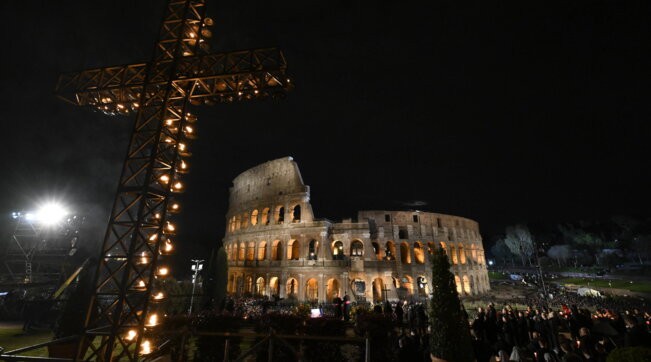The meditations on the Prayer of Jesus written by Pope Francis for the Via Crucis
“Lord Jesus, we look at your cross and understand that you gave everything for us. We dedicate this time to you. We want to spend it close to you, you who prayed from Gethsemane to Calvary. In the Year of Prayer we unite ourselves to your journey of prayer."
Thus begin the meditations written by Pope Francis for the Via Crucis of Good Friday 2024 at the Colosseum. A journey with Jesus along the Via Dolorosa, which the Holy Father accompanies with reflections linked to the Lord's own style of prayer, in this year of preparation for the Jubilee in which Christians are called to rediscover authenticity in their relationship with the Lord.
The prayer of Jesus is first of all one of "dialogue and intimacy", writes the Pope. In the school of the God who was made flesh, every man and woman learns to authentically encounter the Lord. In the first station, Jesus' condemnation to death, it is his "silence" that tells of his intimate relationship with the Father: "Your silence shocks me: it teaches me that prayer is not born from moving lips, but from a heart that knows how to listen: because to pray is to become docile to your Word, it is to adore your presence". Christ’s is a prayer of pure trust. Feeling crushed by the weight of the cross, imagines the Pope, Jesus repeats in his heart: "Father, who art in heaven".
Observing the prayer of Mary, who walks behind her Son until she sees him raised on the cross, also helps believers to increase their faith. The prayer of Our Lady, the Holy Father recalls, is a prayer rich in "memory".
“I realize that my prayer is poor in memory: fast, hasty, a list of needs for today and tomorrow,” writes Pope Francis. “Mary, stop my rushing, help me to remember: to cherish grace, to remember God's forgiveness and wonders, to revive that first love, to savor the wonders of providence, to cry with gratitude."
Similarly, the figure of Simon of Cyrene encourages us to recognize ourselves as being in need of the help of God and of others. “It's not easy to trust, even less easy is it easy to entrust oneself. But those who pray know they are needy and you, Jesus, are used to trusting in prayer. So you don't disdain the help of the Cyrenean. You expose your fragilities to him, this simple man, a farmer returning from the fields. Thank you because, by being supported in your hour of need, you erase the image of an invulnerable and distant god. You are not unstoppable in power, but invincible in love."
The women who follow Jesus along the road to Calvary know how to pray while crying, they are deeply moved by the pain of the Master. “And my prayer … does it know how to cry? Am I moved before you, seeing you crucified for me, before your meek and wounded love? Do I mourn my falsehoods and my inconstancy? Faced with the tragedies of the world, is my heart frozen or does it melt? How do I react to the madness of war, to the faces of children who no longer know how to smile, to mothers who see them malnourished and hungry and have no more tears to shed? You, Jesus, cried over Jerusalem, you cried over the hardness of our hearts. Shake me up inside, give me the grace to cry while praying and to pray while crying."
On the summit of Golgotha, nailed to the cross and at the height of the Passion, Jesus' prayer first becomes a prayer of intercession, then a cry and total abandonment to the will of the Father. “Lord, it is not enough for you to forgive us, you also want to justify us before the Father … ‘they do not know what they are doing’. Defend us, become our advocate, intercede for us", prays the Pope.
Then, before dying, the "unanswered prayer" …. The Pope writes: "You cry out your abandonment to the Father. You, God of the heavens, do not thunder answers, but you ask why? “At the height of the Passion you felt the distance from the Father. You no longer even called him Father, as you always did, but ‘God’, almost as if you were no longer able to identify his face. Why all this? So as to immerse yourself to the pits of the abyss of our pain."
The last character that Pope Francis places at the center is Joseph of Arimathea, whom he calls "the prophet of bold courage". His prayer, which manages to obtain the body of Christ from Pilate, is "tenacious" and with him "deeds follow words".
The Pope adds: “Joseph, remind us that insistent prayer bears fruit and even passes through the darkness of death; that love does not remain unanswered, but gives new beginnings. Your tomb which, unique in history, will be a source of life, was new, just dug into the rock."


